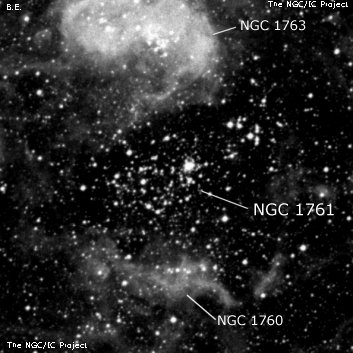
James Dunlop was probably the discoverer of NGC 1761 = D 231 on 6 Nov 1826, recording "a faint round nebula, 1' diameter." His position is 15' too far south, a typical error. This identification is reasonable, assuming D 230 applies to NGC 1763 (Bean Nebula), although Steinicke applies D 230 to NGC 1760, a much less obvious object.
John Herschel independently discovered NGC 1761= h2710 on 11 Dec 1835 and recorded the "chief star 9th mag in a large loose cluster." He made 3 observations as well as including it on a sketch (Plate III, fig 3), along with NGC 1760, 1763 and 1769. Joseph Turner sketched the entire complex as well in Apr 1879 with the Great Melbourne Telescope. NGC 1761 is shown as elongated E-W with a number of stars superimposed, particularly around the edges.
300/350mm - 13.1" (2/17/04 - Costa Rica): this rich group of very faint stars is located just south of the south end of the HII region/cluster NGC 1763. On the west side is a quasi-stellar mag 10 object and the cluster is elongated E-W, 2'x1'. On the west side of the brighter star is another small group of faint stars and haze which may be a continuation of the cluster.
600/800mm - 25" (4/4/19): at 244x; Brey 9 was a fairly bright compact knot on the northwest side of NGC 1761. It had a high surface brightness and ~5" diameter. A faint star was attached at the edge forming a "double".
Notes by Steve Gottlieb